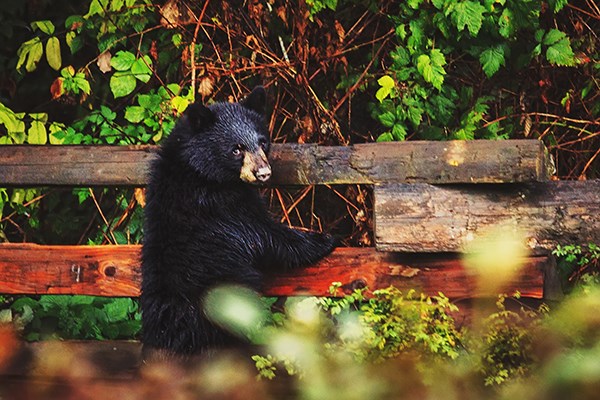Picture the following scenes: A young woman jogs through the Squamish Estuary, headphones attached to her ears as she listens to her latest album download; an experienced mountain biker takes a turn at top speed, trying to improve on his friend’s lap time; parents of young twins take a break after a day of hiking with their toddlers on their backs. At twilight, the kids play, just within eyeshot of their parents, but not within arm’s length.
Many who have recreated in Squamish for a number of years may be able to spot the risky behaviour in the above scenarios, but for those new to the corridor the missteps may be harder to recognize.
“The biggest issue is we have a lot of new people coming to town,” said Vanessa Isnardy, Squamish WildSafeBC’s community coordinator, although she explained that another issue is longtime residents who have become complacent about keeping safe in the outdoors. “I encourage everybody to go and enjoy yourself, but be prepared and have some knowledge of some best practices.”
On Thursday, July 28 at 6 p.m. Isnardy will be presenting, “Recreating and staying safe in wildlife country” at the Squamish Public Library to help new and long-time residents feel prepared to encounter wildlife when they head out on local trails.
Bears are likely the most popular type of wildlife spotted in and around Squamish.
From April 1 to July 22 of this year there were 57 black bear sightings and 58 in 2015, according to WARP ( Wildlife Alert Reporting Program) data.
Local sightings for all species have been comparable year over year, with 75 in 2016, and 68 in 2015, WARP stats show.
Isnardy noted an increase in reports is not always related to an increase in animal activity but can also be attributed to more people reporting their sightings.
“We highly encourage everyone in Squamish to report all sightings of dangerous wildlife in urban areas – bears, cougars, wolves and coyotes – and provide an accurate location,” she said.
Wearing headphones while out on trails is discouraged, Isnardy said. “How are you going to know or sense anything if you are quietly jogging in the woods? A lot of encounters have to do with people surprising an animal and that is where the defensive attack comes in.”
The Squamish Estuary, in particular, is a popular location for local bears.
“I have seen so many logs turned over on the estuary trails,” she said, noting bears frequent the estuary for its many food sources.
Mountain bikers also risk sneaking up on and startling an animal, which can lead to conflict.
“If you are going at a high speed, make sure you have a good line of sight, so you can see what is coming up. If you are going around a corner, you aren’t racing in the Test of Metal, slow down, maybe call out.”
Bear bells have not proven to be very effective, Isnardy said.
Travelling in pairs or a group is best anytime people head out into the woods, she said.
Keeping dogs on a leash is also essential to staying safe, both for the human and the animals, she said. Recent reviews of bear attacks in North America have found that dogs were involved about 50 per cent of the time.
“Bears and wolves have always been competitors so it seems natural that a bear is going to want to chase away its competitor… and dogs are so closely related to wolves,” she said.
Bear spray is something Isnardy said everyone in Squamish should have and can be purchased at local outdoor equipment stores.
“With bear spray you don’t have to be accurate,” she said, suggesting the spray be kept on a holster on the hip while hiking or in the water holder on a bike. “You encounter a bear, you see it, you stop, assess the situation,” she said.
If the bear is not interested in the humans, bear spray is not necessary, she stressed.
“Black bears, most of the time – they grew up in woodlands – so they do flight over fight,” she said. “They are used to going up trees and avoiding confrontation, so most encounters in Squamish with black bears where they are used to people being around, they aren’t interested in us, so most encounters are very passive,” she said.
If the bear is acknowledging the human and starts to come closer, that is the time to use the bear spray. When you come face-to-face with a bear, use the spray to “make a wall between you and the animal,” she said.
For cougars, Isnardy said studies show one of the main causes of attacks is small children left unattended.
They don’t usually attack adults, she said, or children with adults. Parents should stay close to their young children in the backcountry and pick them up if a cougar is spotted.
Twilight is when animals are most active, so it is a time to avoid being out in the woods if possible, she said.
Isnardy reiterated people don’t need to be frightened or avoid going out to explore for fear of wildlife. “I just want them to have some information to help guide them in what they are doing.”
To report wildlife sightings call the B.C. Conservation Officer Service 24-hour hotline at 1-877-952-7277.



